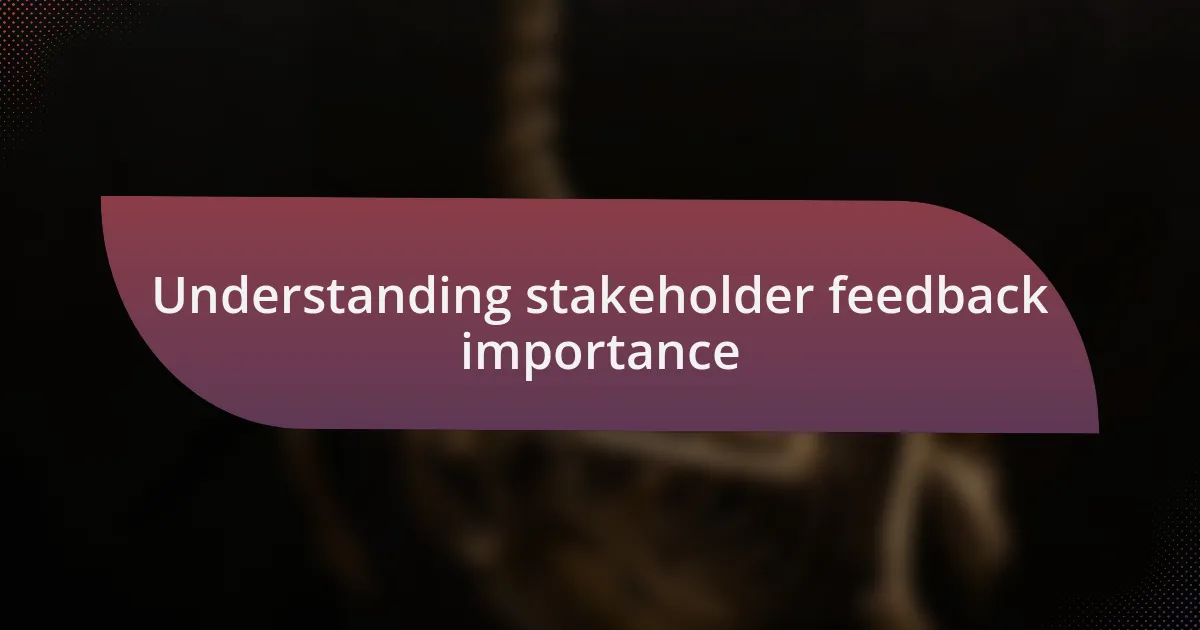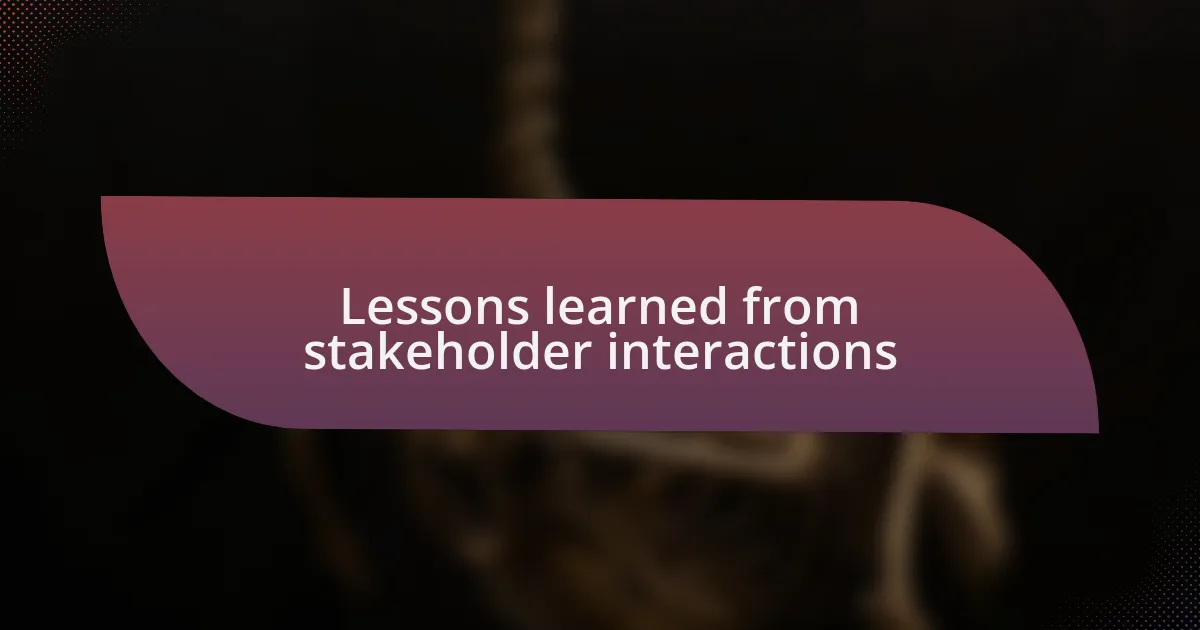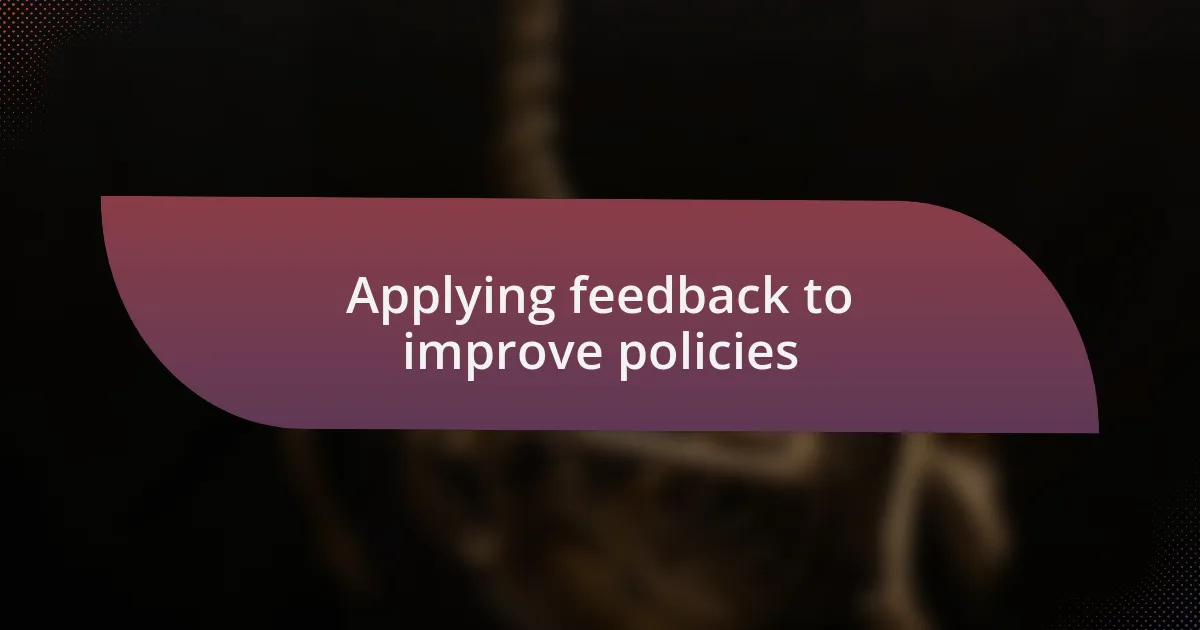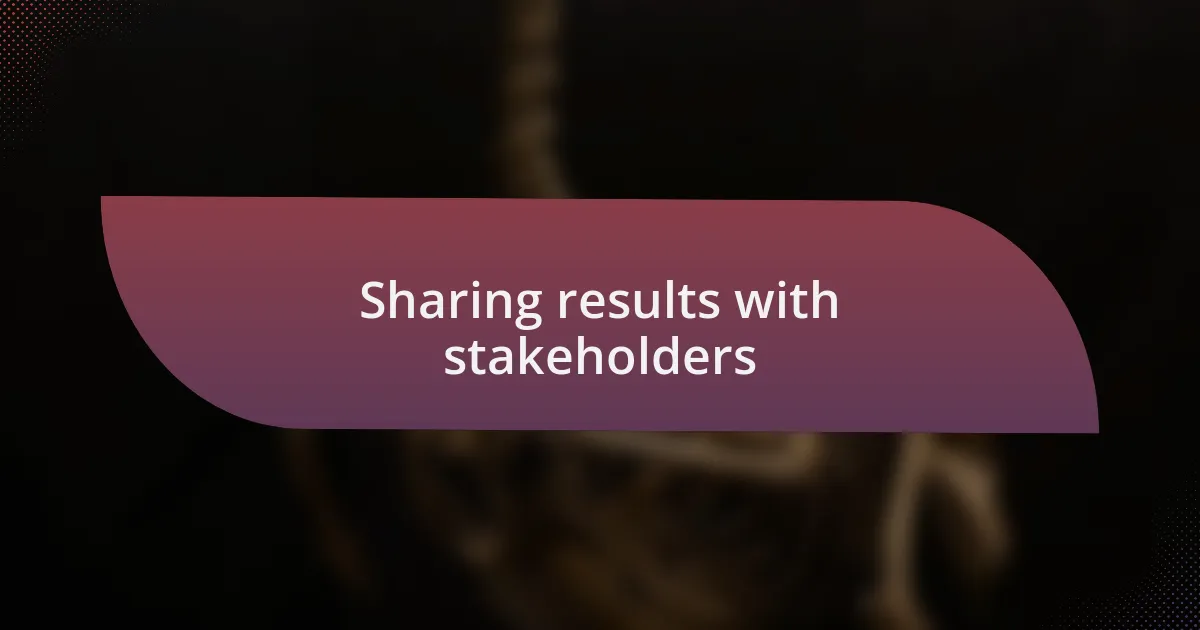Key takeaways:
- Stakeholder feedback is essential for aligning policies with community needs and fostering trust and collaboration.
- Effective collection methods, such as surveys, focus groups, and interviews, can reveal deeper insights and enhance project direction.
- Analyzing feedback through categorization and deeper inquiry can uncover significant themes and insights that shape policy improvements.
- Sharing results with stakeholders promotes transparency, accountability, and collaborative problem-solving, strengthening relationships for future initiatives.

Understanding stakeholder feedback importance
Understanding stakeholder feedback is crucial because it provides a window into the perspectives of those affected by policy decisions. In my experience, I’ve seen how incorporating input from various stakeholders can transform a project from merely acceptable to truly impactful. Have you ever considered how a small but vocal group can reshape a policy’s direction?
Delving into feedback often uncovers insights that might otherwise go unnoticed. For instance, I once worked on a policy initiative where initial assumptions clashed with community realities. Listening closely to stakeholders illuminated gaps in our approach that we hadn’t considered, enabling us to adjust our strategy for better alignment with their needs.
Moreover, embracing stakeholder feedback fosters trust and collaboration. I remember a project where we invited stakeholders to share their viewpoints openly; the dialogue not only enriched our understanding but also strengthened our relationships moving forward. When stakeholders feel heard, they’re more likely to engage actively, setting the stage for more effective partnerships. Can you see how this two-way communication can lead to more sustainable outcomes?

Methods for collecting stakeholder feedback
When it comes to collecting stakeholder feedback, I’ve found that surveys can be incredibly effective. They offer a structured way to gather opinions from a wider audience, allowing for both quantitative and qualitative insights. In one project, a simple online survey illuminated unexpected trends in community sentiment that we’d never have captured through informal conversations.
Focus groups, too, have been a game changer for me. By bringing together a diverse group of stakeholders, I’ve witnessed firsthand how dynamic discussions can spark new ideas. I remember facilitating a focus group where participants built off each other’s thoughts, leading to breakthroughs that reshaped our entire approach. Have you ever experienced a moment where group synergy transformed an ordinary meeting into something extraordinary? It really highlights the value of collective input.
Another method that’s proven invaluable is one-on-one interviews. These intimate conversations allow for deeper exploration of individual perspectives. I often find that stakeholders open up more in this setting, revealing their true feelings and concerns. In my experience, these dialogues can shift the course of a project because they provide context behind the feedback. Isn’t it fascinating how personal stories can shed light on broader trends? Collectively, these methods create a rich tapestry of insights that inform and enhance our work in policy research.

Analyzing feedback for insights
Analyzing stakeholder feedback can be a revealing process that transforms raw data into actionable insights. In one instance, I sifted through a mountain of comments from a recent community forum. What struck me was how often stakeholders echoed similar concerns about policy implications. It was as if their voices harmonized, illustrating a community wide apprehension that I hadn’t anticipated. This repetition highlighted areas where we needed to focus our attention. Have you ever stumbled upon a theme in feedback that changed your perspective completely?
As I delved deeper into the feedback, I discovered that categorizing responses helped to clarify complex sentiments. For example, creating separate themes for common issues, like accessibility and transparency, allowed me to pinpoint specific areas for improvement. I recall a project where this approach not only streamlined our objectives but also empowered the stakeholders, making them feel heard and valued. Isn’t it fascinating how organization can turn chaos into clarity?
Additionally, I realized that looking beyond the surface of the feedback is crucial. One particular stakeholder shared a seemingly minor concern, yet upon further inquiry, it unveiled a deeper systemic issue affecting countless others. This taught me that every piece of feedback has the potential to uncover significant insights if we are willing to dig a little deeper. Have you ever discovered a hidden gem in feedback that led to a major breakthrough?

Lessons learned from stakeholder interactions
Engaging with stakeholders has revealed unexpected lessons that have enriched my understanding of policy dynamics. For instance, during a workshop, I noticed how participants often related their personal experiences to larger policy challenges. Their willingness to share stories transformed the discussion, creating a vibrant dialogue that illuminated nuances I hadn’t considered. Isn’t it amazing how personal narratives can bridge the gap between abstract policies and real-world impact?
Through this journey, I’ve learned that the way we ask questions significantly influences the depth of responses we receive. I once facilitated a session where open-ended questions led to a cascade of insights, shaping the direction of our project. I could feel the energy in the room shift as stakeholders realized their input mattered. Have you ever felt that spark when a simple question opens a floodgate of insights? It’s a reminder that our approach can either hinder or nurture genuine engagement.
Moreover, I found that valuing silent voices can sometimes yield the most profound lessons. In one instance, a quieter stakeholder hesitated to speak up but later shared a critical point in a small group setting. That experience taught me the importance of creating an inclusive environment where everyone feels safe to share. How often do we overlook those who seem less vocal, yet possess the wisdom we desperately need? This has fundamentally reshaped the way I engage with stakeholders, emphasizing the power of listening over speaking.

Applying feedback to improve policies
Applying feedback offers a pathway to refining policies. I remember a situation where stakeholder feedback highlighted the need for clearer communication regarding a new initiative. By directly addressing their concerns in revised policy drafts, we not only created documents that resonated better but also fostered a sense of ownership among stakeholders. Isn’t it powerful when their voices become part of the solution?
In another project, we pivoted our approach entirely based on stakeholder suggestions about program effectiveness. They shared specific examples of challenges they faced, prompting me to rethink the implementation strategy. This shift impacted not just the success of the policy but also enhanced relationships built on trust and transparency. Have you seen how a single piece of feedback can lead to significant breakthroughs?
Moreover, I found that integrating stakeholder feedback wasn’t merely a checkbox exercise; it transformed the policy-making culture within our team. When I initiated regular feedback loops, the team became more adaptive and responsive. It created an environment where ideas flowed freely. Isn’t it fascinating how embracing feedback can turn a rigid process into a collaborative journey toward improvement?

Sharing results with stakeholders
Sharing results with stakeholders is a vital step in fostering collaboration and trust. I recall sharing the outcomes of a recent project with our stakeholders, highlighting not just the successes, but also the lessons learned. Their reactions were incredibly insightful; some expressed relief, while others had valuable suggestions that could enhance future projects. Isn’t it intriguing how transparent communication can open doors to deeper connections?
In another instance, we organized a roundtable to discuss our findings in detail. The feedback I received was invaluable, as stakeholders were eager to voice their perspectives on the results. I was struck by their enthusiasm; it reminded me of how important it is to create a space where everyone feels their input is valued. Have you ever noticed that the more you engage, the richer the conversation becomes?
Additionally, sharing results allowed me to demonstrate accountability, a critical element in stakeholder relationships. I remember presenting data that indicated a lower-than-expected impact for one policy. Instead of shying away from the less favorable results, I acknowledged them, fostering a culture of honesty. This openness paved the way for collaborative problem-solving. Isn’t it refreshing to recognize that each setback can be a stepping stone towards innovation?